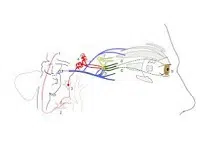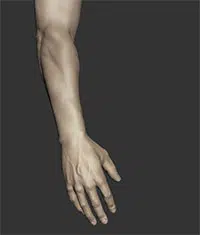 Innervation is a concept that is used in the field of anatomy to name the action developed by the nervous system on organ functions. The verb innervate, in this framework, is used with respect to what a nerve does when it reaches some body structure .
Innervation is a concept that is used in the field of anatomy to name the action developed by the nervous system on organ functions. The verb innervate, in this framework, is used with respect to what a nerve does when it reaches some body structure .
When motor fibers send impulses to glands or muscles and when sensory fibers receive sensitivity from receptors, innervation occurs. The nerve fibers of the sympathetic trunks and the vagus nerves, to cite one case, allow the innervation of the heart .
The innervation of the eye , on the other hand, is produced by the cranial nerves. Various nerves are responsible for collecting the sensitivity of the orbital cavity and the functions of the external muscles of the eye.
Each cutaneous nerve, meanwhile, enables the innervation of a specific area of the skin . The region innervated by a single spinal nerve with its spinal ganglion is called the dermatome .
At a general level it can be said that innervation is associated with electrical impulses . An electrical discharge wave passes through the cell membrane and modifies its potential (the distribution of electrical charge). Innervation involves the transmission of an impulse , for example from a nerve cell to a muscle.
It is important not to confuse innervation with irrigation . While the first is linked to the transmission of nervous impulses, irrigation refers to the introduction of a fluid (such as blood ). An organ, in this way, is innervated by certain nerves and irrigated by certain blood vessels.
There is a condition known as anastomosis that is often referred to as anomalous innervation ; However, given its frequent appearance in humans, it is not considered an anomaly as much as a variation. One of the most common types of anastomosis takes place in the forearm and covers the area between the median and ulnar nerves.
 The anomalous innervation that occurs between these nerves is of great importance for the clinical setting, since it usually gives rise to variations in the motor innervation, which is why it also causes alterations in the intrinsic hand muscles. Various nerve conduction and anatomical studies have shown that this phenomenon creates confusion when it is necessary to carry out an accurate diagnosis.
The anomalous innervation that occurs between these nerves is of great importance for the clinical setting, since it usually gives rise to variations in the motor innervation, which is why it also causes alterations in the intrinsic hand muscles. Various nerve conduction and anatomical studies have shown that this phenomenon creates confusion when it is necessary to carry out an accurate diagnosis.
Of the various descriptions that scientists have made about the branches that connect the ulnar and median nerves, the first dates back to 1741 and was made by Berettini , who accompanied it with a series of illustrations. Later, other scholars added their points of view to the subject, and among them were Martin, Gruber, Brooks, Spourgitis, Richie, Gehwolf, Hirasawa, Rowntree, Meals and Sunderland, who published their findings between 1763 and 1978.
In 1966, Mannerfield pioneered the use of electrophysiological studies to detect anastomoses between two nerves. The descriptions of the anomalous innervations in the forearm have been made taking into account various points of their paths in or below the elbow, from the distal or proximal part of the forearm and also in the palm of the hand. The communicating branches found in the proximal part of the forearm called Martin-Gruber anastomoses are those that originate from the median nerve and reach the ulnar nerve.
On the other hand, the name Marinacci or reverse Martin-Gruber anastomosis ( Gruber-Martin anastomosis ) is given to the anomalous innervation that goes from the ulnar nerve to the median. In the palm of the hand, the Richie-Cannieu anastomosis takes place, which connects the deep branch of the ulnar and the recurrent branch of the median.
